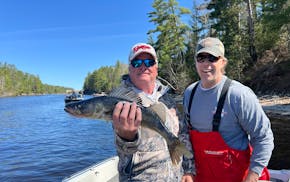Annie Battle Lake in central Minnesota radiated with the possibility of good fishing as Dean Paron and three friends hauled their sleds of jigging rods and other gear onto the ice.
They fanned out across the lake on the mid-March day in 2021, pursuing trophy bluegill. The fish appeared, but they also made the group work. The anglers separated and chased the bite around the 300-acre lake. Again and again, Paron corkscrewed his hand auger through a foot or more of soft surface ice before penetrating 2½ feet of solid ice — safe ice.
Paron, a Department of Natural Resources supervisor, shed his parka in the 50-degree warmth and left behind the ice picks and rope he knew to carry as a volunteer emergency responder.
On his 40th or so hole, he got an unsettling surprise. His auger bit quickly, unexpectedly tearing through just 4 inches of crumbly, rotting ice before hitting water. He was about 45 yards off the western shore.
"That's not good," he thought.
Eager for ice
Minnesotans are eager to recreate when temperatures plummet and "hard water" begins to form.
Sometimes they are too eager, said Nicole Biagi, DNR ice safety coordinator, amid warnings about the unpredictability of new ice.
Several Minnesotans have been killed and rescued in thin ice incidents in the last several weeks. The body of a Minnesota teen was recovered Tuesday from a lake near Longville after he and a friend broke through ice on an ATV. Earlier this month, a former Duluth pastor disappeared and was found dead after a skating trip on Lake Superior. Two boys were rescued after getting stranded on a reservoir's thin ice near Rochester, and three people plunged through ice in separate incidents in Woodbury.
State conservation officers continue to encounter a lot of ice anglers and urge caution in their weekly reports from the field.
"People are excited and there is some impatience," Biagi said.
A range of factors affect ice thickness and stability. Fluctuating temperatures and high winds can expand and contract ice, creating pressure ridges and cracks. A new layer of snow can insulate early ice and hinder a thorough freeze.
John Downing knows ice and its mixed makeup better than most as director at Minnesota Sea Grant, which specializes in water science at the University of Minnesota. The trouble that Paron walked into on Annie Battle Lake likely was caused by current from an inlet that disrupted how ice molecules move and solidify, he said, a common but easily overlooked occurrence.
Significant swings in ice thickness don't surprise Downing. Lake research has shown that its thickness can vary more than 50% on lakes — especially when a stream flows in or out. Groundwater's warm temperature can melt ice from the bottom up, too.
Downing said Minnesotans shouldn't expect to have the same ice on their favorite bodies of water all the time on the same dates. Not in an era of warming winters well-documented by state climatologists.
"Our expectation of ice and its formation really needs to be revised," he said. "You have to be incredibly more careful. [Ice is] forming much later and thickening much less than has been true over time."
'Fight or flight'
On Annie Battle Lake at Glendalough State Park, Paron didn't know about the underwater current running from the northwest shore. It had washed away the chance of solid ice forming where he stood.
He took three steps and dropped like a sinker through the cloudy ice.
Paron, 54, felt a jolt through his body as he surfaced — the cold shock of the frigid water. But he'd kept his mouth closed underwater, and it allowed him to catch his breath and avoid choking.
"It was a pure fight-or-flight response," Paron said. "Totally everything kicked in in the panic. Everything comes so quickly."
Paron thrust out his arms to brace himself, but his hands only found brittle ice that broke when he clawed it. Then, he felt water below flow across his legs and Muck boots. A terrifying thought flashed: I could get swept under.
He kept grabbing for something solid but the slushy hole at his shoulders widened. The protective ice picks that he should have carried to dig in and pull himself out were on a gear sled about 100 yards away.
Adrenaline spiking, Paron controlled his breathing while his legs kicked against the current.
The clock was ticking. Somehow, he had to get out. His friends were at least a half a football field away.
Cascading effects
Drowning kills most thin-ice victims. The initial frigid shock to the body can trigger hyperventilation, or rapid breathing, that depletes the blood's carbon dioxide levels. Dizziness and confusion follow. The blow to the body also can spike blood pressure and trigger an irregular heartbeat.
Biagi and some ice safety experts cite the 1-10-1 principle, reflecting the cascading effects of cold water immersion and the tight window to find safety. Victims need to calm their breathing and avoid panicking in the first anxious minute. Over the next 10 minutes, victims' muscles and nerves will succumb to the cold water, making it harder to use arms and legs.
Finally, if unable to get out of the water, the victim has one hour before possibly succumbing to worsening hypothermia. The rapid loss of body temperature can trigger a variety of physiological changes, beginning with shivering, confusion and slurred speech. Moderate hypothermia brings shallow breathing and semi-consciousness, then comes the threat of coma or cardiac arrest.
Finding safety
Paron, a stream habitat specialist, credits his emergency training for managing to keep his wits in the first, frantic seconds. He pursed his lips and slowed his breathing.
His plunge had gotten the attention of a friend, who ran back to their gear for his rope and ice picks — two items he had trained repeatedly to carry no matter the conditions.
Paron stuck to his plan: In the stew of ice chunks and water, he found a solid edge. Grasping at it, he kicked his legs to elevate his torso and then, like a walrus, belly-rolled onto the surface of the lake. The move was a technique he'd done "a thousand times" in a cold water immersion suit, he said.
But Paron crawled briefly and broke through a second time. He kicked for another 30 seconds before finding a firm edge to flop onto and rolled to thicker ice. He estimated he'd been submerged for about two minutes. Once out, he peeled off his drenched T-shirt and sweatshirt and found warmth in his parka and, later, the woodstove of a park cabin.
Today, Paron, of Two Harbors, still regrets lowering his guard on Annie Battle.
"I had gotten lax. I wasn't carrying ice picks with me. I didn't have a rope. I didn't have flotation. I spent most of the day feeling I was ultimately safe," he said. "If I wasn't able to get out, I'm not quite sure what would have happened. We were the only people on the lake for the day and a long way from any road, so I don't know if anyone would have seen or heard me."
It legitimized the common warning to Minnesotans: No ice is 100% safe.
Now, he takes the extra step of investigating a lake ahead of time, while continuing to do the winter activities he loves like ice fishing and spearing and skiing across lakes.
"It made me more aware that having safety gear with me and being more aware of my surroundings are always important things," Paron said.

Anderson: Crane Lake gives up its walleyes — and its memories

Summer-like sun and warmth cast glow on Minnesota fishing opener

Show us your fish

Talon Metals steps up exploratory drilling for a nickel mine in Minnesota, cites 'exceptional' find

